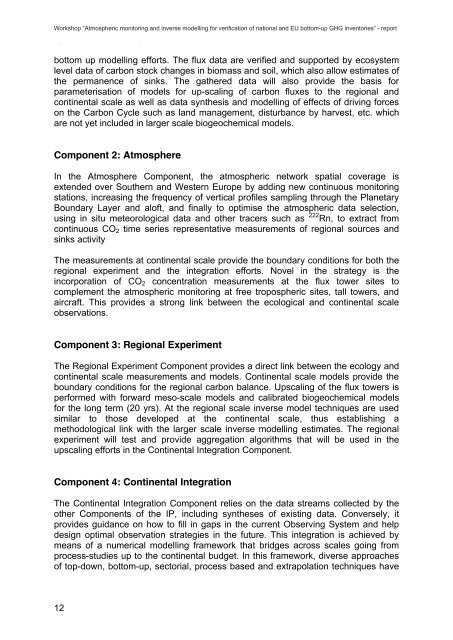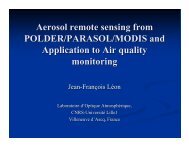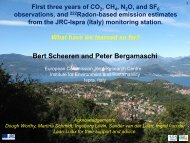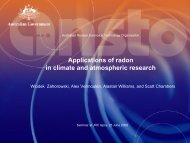download - Climate Change and Air Quality Unit - Europa
download - Climate Change and Air Quality Unit - Europa
download - Climate Change and Air Quality Unit - Europa
You also want an ePaper? Increase the reach of your titles
YUMPU automatically turns print PDFs into web optimized ePapers that Google loves.
Workshop “Atmospheric monitoring <strong>and</strong> inverse modelling for verification of national <strong>and</strong> EU bottom-up GHG inventories” - reportWorkshop "Atmospheric monitoring <strong>and</strong> inverse modelling for verification of national <strong>and</strong> EU bottomupGHG inventories " - reportbottom up modelling efforts. The flux data are verified <strong>and</strong> supported by ecosystemlevel data of carbon stock changes in biomass <strong>and</strong> soil, which also allow estimates ofthe permanence of sinks. The gathered data will also provide the basis forparameterisation of models for up-scaling of carbon fluxes to the regional <strong>and</strong>continental scale as well as data synthesis <strong>and</strong> modelling of effects of driving forceson the Carbon Cycle such as l<strong>and</strong> management, disturbance by harvest, etc. whichare not yet included in larger scale biogeochemical models.Component 2: AtmosphereIn the Atmosphere Component, the atmospheric network spatial coverage isextended over Southern <strong>and</strong> Western Europe by adding new continuous monitoringstations, increasing the frequency of vertical profiles sampling through the PlanetaryBoundary Layer <strong>and</strong> aloft, <strong>and</strong> finally to optimise the atmospheric data selection,using in situ meteorological data <strong>and</strong> other tracers such as 222 Rn, to extract fromcontinuous CO 2 time series representative measurements of regional sources <strong>and</strong>sinks activityThe measurements at continental scale provide the boundary conditions for both theregional experiment <strong>and</strong> the integration efforts. Novel in the strategy is theincorporation of CO 2 concentration measurements at the flux tower sites tocomplement the atmospheric monitoring at free tropospheric sites, tall towers, <strong>and</strong>aircraft. This provides a strong link between the ecological <strong>and</strong> continental scaleobservations.Component 3: Regional ExperimentThe Regional Experiment Component provides a direct link between the ecology <strong>and</strong>continental scale measurements <strong>and</strong> models. Continental scale models provide theboundary conditions for the regional carbon balance. Upscaling of the flux towers isperformed with forward meso-scale models <strong>and</strong> calibrated biogeochemical modelsfor the long term (20 yrs). At the regional scale inverse model techniques are usedsimilar to those developed at the continental scale, thus establishing amethodological link with the larger scale inverse modelling estimates. The regionalexperiment will test <strong>and</strong> provide aggregation algorithms that will be used in theupscaling efforts in the Continental Integration Component.Component 4: Continental IntegrationThe Continental Integration Component relies on the data streams collected by theother Components of the IP, including syntheses of existing data. Conversely, itprovides guidance on how to fill in gaps in the current Observing System <strong>and</strong> helpdesign optimal observation strategies in the future. This integration is achieved bymeans of a numerical modelling framework that bridges across scales going fromprocess-studies up to the continental budget. In this framework, diverse approachesof top-down, bottom-up, sectorial, process based <strong>and</strong> extrapolation techniques have12








